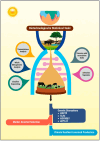Applications of Next-Generation Sequencing Technologies and Statistical Tools in Identifying Pathways and Biomarkers for Heat Tolerance in Livestock
- PMID: 39728955
- PMCID: PMC11680151
- DOI: 10.3390/vetsci11120616
Applications of Next-Generation Sequencing Technologies and Statistical Tools in Identifying Pathways and Biomarkers for Heat Tolerance in Livestock
Abstract
The climate change-associated abnormal weather patterns negatively influences the productivity and performance of farm animals. Heat stress is the major detrimental factor hampering production, causing substantial economic loss to the livestock industry. Therefore, it is important to identify heat-tolerant breeds that can survive and produce optimally in any given environment. To achieve this goal, a clearer understanding of the genetic differences and the underlying molecular mechanisms associated with climate change impacts and heat tolerance are a prerequisite. Adopting next-generation biotechnological and statistical tools like whole transcriptome analysis, whole metagenome sequencing, bisulphite sequencing, genome-wide association studies (GWAS), and selection signatures provides an opportunity to achieve this goal. Through these techniques, it is possible to identify permanent genetic markers for heat tolerance, and by incorporating those markers in marker-assisted breeding selection, it is possible to achieve the target of breeding for heat tolerance in livestock. This review gives an overview of the recent advancements in assessing heat tolerance in livestock using such 'omics' approaches and statistical models. The salient findings from this research highlighted several candidate biomarkers that have the potential to be incorporated into future heat-tolerance studies. Such approaches could revolutionise livestock production in the changing climate scenario and support the food demands of the growing human population.
Keywords: biomarkers; biotechnological tools; heat stress; next-generation sequencing; thermo-tolerance.
Conflict of interest statement
The authors declare no conflicts of interest.
Figures
Similar articles
-
Climate-Resilient Dairy Cattle Production: Applications of Genomic Tools and Statistical Models.Front Vet Sci. 2021 Apr 29;8:625189. doi: 10.3389/fvets.2021.625189. eCollection 2021. Front Vet Sci. 2021. PMID: 33996959 Free PMC article. Review.
-
Enhancement of Plant Productivity in the Post-Genomics Era.Curr Genomics. 2016 Aug;17(4):295-6. doi: 10.2174/138920291704160607182507. Curr Genomics. 2016. PMID: 27499678 Free PMC article.
-
Adaptation to hot climate and strategies to alleviate heat stress in livestock production.Animal. 2012 May;6(5):707-28. doi: 10.1017/S1751731111002448. Animal. 2012. PMID: 22558920 Review.
-
Genome-wide association study of a thermo-tolerance indicator in pregnant ewes exposed to an artificial heat-stressed environment.J Therm Biol. 2021 Oct;101:103095. doi: 10.1016/j.jtherbio.2021.103095. Epub 2021 Sep 16. J Therm Biol. 2021. PMID: 34879913
-
Review: Adaptation of animals to heat stress.Animal. 2018 Dec;12(s2):s431-s444. doi: 10.1017/S1751731118001945. Epub 2018 Aug 24. Animal. 2018. PMID: 30139399 Review.
Cited by
-
Whole genome resequencing data of the Iranian cashmere goat breed.BMC Res Notes. 2025 Aug 19;18(1):363. doi: 10.1186/s13104-025-07431-9. BMC Res Notes. 2025. PMID: 40830513 Free PMC article.
References
-
- CoastAdapt: Global Climate Change and Sea-Level Rise. 2017. [(accessed on 14 October 2024)]. Available online: https://coastadapt.com.au/global-climate-change-and-sea-level-rise.
-
- Pachauri R.K., Allen M.R., Barros V.R., Broome J., Cramer W., Christ R., Church J.A., Clarke L., Dahe Q., Dasgupta P., et al. In: Climate Change 2014: Synthesis Report. Contribution of Working Groups I, II and III to the Fifth Assessment Report of the Intergovernmental Panel on Climate Change. Pachauri R., Meyer L., editors. IPCC; Geneva, Switzerland: 2014. p. 151.
-
- Sejian V., Bahadur S., Indu S., Bagath M., Malik P., Soren N., Kumar D., Maurya V., Shinde A., Sahoo A., et al. Sheep and Goat Meat Production and Processing. Satish Serial Publishing House; Delhi, India: 2016. Environmental Stress Impact on Small Ruminants Production; pp. 157–181.
Publication types
LinkOut - more resources
Full Text Sources


